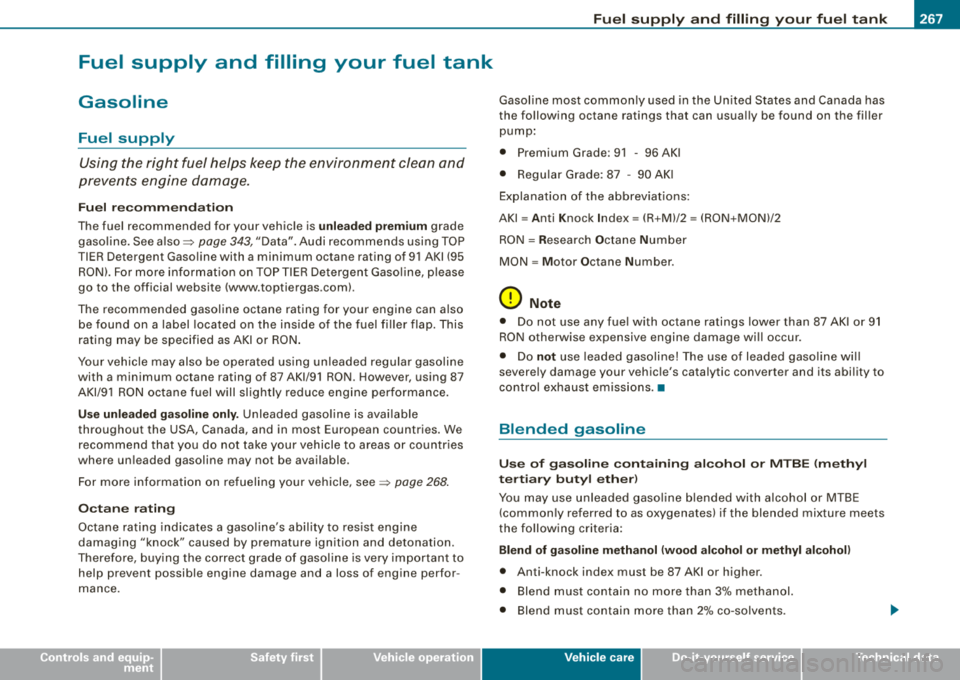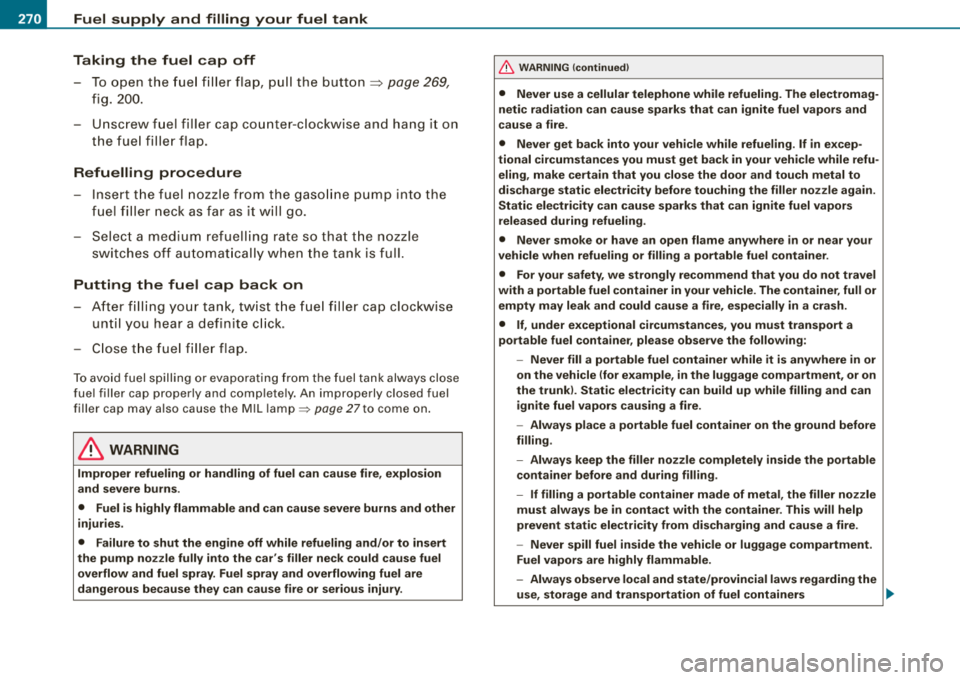fuel pump AUDI A4 AVANT 2008 Owners Manual
[x] Cancel search | Manufacturer: AUDI, Model Year: 2008, Model line: A4 AVANT, Model: AUDI A4 AVANT 2008Pages: 368, PDF Size: 46.19 MB
Page 269 of 368

Fuel supply and filling your fuel tank
Gasoline
Fuel supply
Using the right fuel helps keep the environment clean and
prevents engine damage.
F u el re comm end ati on
The fuel recommended for your vehic le is unle ad ed pr em ium grade
gaso line . See
a lso => page 343, "Data". Audi recommends using TOP
TIER Detergent Gaso line with a minimum octane rating of 91 AKI (95
RON). For more informat ion on TOP TIER Detergent Gaso line, p lease
go to the official website (www .toptiergas .com) .
The recommended gasoline octane rating for your engine can also be found on a label located on the ins ide of the fuel fi ller flap. This
rating may be specified as A KI o r RON .
Your vehicle may also be operated us ing u nleaded regular gasoline
with a minimum octane rating of 87 AKl/91 RO N. However, using 87
A Kl/9 1 RON octane fuel w ill sl ight ly reduce engine performance.
U se unleaded gasoline only. Unleaded gaso line is avai lable
throughout the USA, Canada, and in most European countries. We
recommend that you do not take your vehicle to areas or countr ies
where un leaded gasoline may not be available .
For more informati on on refueling yo ur vehicle,
see => page 268 .
Octan e ra ting
Octane rating indicates a gaso line's abil ity to res ist engine
damaging
" k nock" caused by premature ign ition and detonation.
Therefore, buying t he correct grade of gasoline is very i mpo rtant to
help prevent possible engine damage and a loss of engine perfor
mance.
Fu el supply and fillin g your fu el tank
Gasol ine most common ly used in the Un ited States and Canada has
the fo llowing octane ratings that can usua lly be found on the filler
pump :
• Premium Grade : 91 - 96 AKI
• Regu lar Grade: 87 -90 AKI
Explanation of t he abbrev iat ions:
AKI = Anti Knock Index= (R +Ml/2 = (RO N+MON)/2
RO N= R esearc h Octane Num ber
MON = M otor Octane Number .
0 Note
• Do n ot use any fue l with octane ratings l ower than 87 AKI o r 91
RO N otherwise expensive engine damage wi ll occur.
• Do
not use leaded gasoline! The use of leaded gaso line wi ll
severe ly damage your vehic le's catalytic converter and its abi lity to
co ntr ol exhaus t em issions. •
Blended gasoline
Use of ga soline containing alcohol or MTBE (m ethyl
tert iary but yl ether )
You may use unleaded gaso line blended with alcohol or MTBE
(commonly referred to as oxygenates) if the blended mixture meets
the fo llow ing criteria:
Blend of ga soline meth anol (wood alcohol or methyl alc ohol)
• Anti-knock index must be 87 AKI or higher .
• Blend must contain no more than 3% methanol.
• Blend must contain more than 2% co-solvents.
Vehicle care
Page 272 of 368

Fuel supply and filling your fuel tank
Taking the fuel cap off
- To open the fuel filler flap, pull the button~ page 269,
fig. 200.
- Unscrew fuel filler cap counter-clockwise and hang it on the fuel filler flap.
Refuelling procedure
- Insert the fuel nozzle from the gasoline pump into the
fuel filler neck as far as it will go.
- Select a medium refuelling rate so that the nozzle
switches off automatically when the tank is full.
Putting the fuel cap back on
- After filling your tank, twist the fuel filler cap clockwise
until you hear a definite click.
- Close the fuel filler flap.
To avoid fuel spilling or evaporating from the fuel tank always close
fuel filler cap properly and completely. An improperly closed fuel
filler cap may also cause the MIL lamp => page 27to come on.
& WARNING
Improper refueling or handling of fuel can cause fire, explosion
and severe burns .
• Fuel is highly flammable and can cause severe burns and other
injuries.
• Failure to shut the engine off while refueling and/or to insert
the pump nozzle fully into the car's filler neck could cause fuel
overflow and fuel spray. Fuel spray and overflowing fuel are
dangerous because they can cause fire or serious injury.
& WARNING (continued)
• Never use a cellular telephone while refueling. The electromag
netic radiation can cause sparks that can ignite fuel vapors and
cause a fire .
• Never get back into your vehicle while refueling. If in excep
tional circumstances you must get back in your vehicle while refu
eling, make certain that you close the door and touch metal to
discharge static electricity before touching the filler nozzle again .
Static electricity can cause sparks that can ignite fuel vapors
released during refueling .
• Never smoke or have an open flame anywhere in or near your
vehicle when refueling or filling a portable fuel container.
• For your safety, we strongly recommend that you do not travel
with a portable fuel container in your vehicle. The container, full or
empty may leak and could cause a fire, especially in a crash.
• If, under exceptional circumstances, you must transport a
portable fuel container, please observe the following:
- Never fill a portable fuel container while it is anywhere in or
on the vehicle (for example, in the luggage compartment, or on
the trunk). Static electricity can build up while filling and can
ignite fuel vapors causing a fire.
- Always place a portable fuel container on the ground before
filling.
- Always keep the filler nozzle completely inside the portable container before and during filling.
- If filling a portable container made of metal, the filler nozzle must always be in contact with the container. This will help
prevent static electricity from discharging and cause a fire.
- Never spill fuel inside the vehicle or luggage compartment .
Fuel vapors are highly flammable.
- Always observe local and state/provincial laws regarding the
use, storage and transportation of fuel containers
~
Page 329 of 368

Fuses and bulbs -
----------------
0 Note No. Equipment Amps
• On no account should fuses be repaired (e.g. patched up with tin 13 Steering column module 10
foil or wire) as this may cause serious damage elsewhere in the elec -14 Brake lights 10
trical circuit or cause fire.
15 Instrument cluster, Navigation system 10
• If a fuse blows repeatedly, do not keep replacing it. Instead, have
the cause for the repeated short circuit or overload tracked and Garage door opener
5
fixed.
•
Level, tire pressure control, park assist,
17 light/rain sensor 10
Fuse list Automatic headlight range control, left 5
Fuses which can be replaced. 19 Fog lights, rear fog light 15
20
Not used
No. Equipment Amps
21 Not used
1 Air conditioner 10 Front doors 15
2
Footwell illumination 5 23 Rear doors 15
3 Heated washer jets 5 Central convenience electrical system 20
4 Radiator fan 5 25 Heater blower 30
5
Telephone, oil level sensor, multifunction 10 26 Rear window defogger 30
switch, rear heated Seat, shift gate
27 Socket for trailer towing (controller) 30
6
Air conditioner (air quality sensor), air pressure 5 28 Fuel pump 20 sensor
Electronic Stabilization Program (ESP), brake
29 Not used
7 light switch, clutch pedal switch, steering angle 10 Power sunroof 20
sensor Automatic transmission, mirror dimming, diag-
31 15 8 Telephone 5 nosis socket
9 Brake booster (vacuum pump) 15 Towing assembly 15
10
Automatic headlight beam adjustment, auto -5 33 Cigarette
lighter 20
matic headlight range control, right
Electrical socket 20
11
Airbag 5 35 Luggage compartment socket 20
12
Diagnosis socket 10 Windshield wiper system 30
Do -it -yourself service